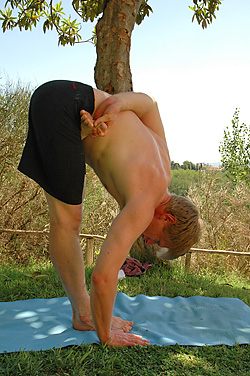alan little’s weblog
pratyahara
5th July 2005 permanent link
The “ashtanga” in “ashtanga vinyasa yoga” – the style of yoga I practice – means “eight limbs”, and refers to the eight limbs of classical yoga as described in the Yoga Sutras of Patanjali.
The Yoga Sutras are about two thousand years old, give or take a few hundred years. (I’m writing this on the train, without access to textbooks or the internet). They are mainly about the mental states associated with, and obstacles to, advanced meditation. Asana – yoga postures – is mentioned as the third of the eight limbs, but only very briefly: three verses out of a hundred-odd.
There are Indian carvings that appear to be of gods sitting in yogic meditation postures from thousands of years before Patanjali, but the first written records we have of anything resembling the elaborate physical postures and breathing exercises most people in the west now associate with the word “yoga” are much later – the Hatha Yoga Pradipika and related texts are only about six hundred years old. It’s entirely possible that earlier written texts existed but have been lost, or that the Hatha Yoga Pradipika etc. recorded practices that were already ancient oral traditions; but there’s no proof of it.
So did Patanjali practice anything that outwardly resembled what we now call “ashtanga vinyasa yoga”? Probably not. I would be quite surprised to see video footage – or even ink-on-palmleaf drawings – of him demonstrating the modern ashtanga sixth series.
How, then, does an outwardly very physical and even athletic-looking practice like modern “ashtanga vinyasa yoga” relate to the eight limbs of classical yoga as recorded by Patanjali? It’s a legitimate question, quite often asked by sceptical practitioners of other forms of yoga and meditation. Here's how.
For the point I want to illustrate I’ll skip over limbs one, two and four – yama, niyama and pranayama – although they’re involved too – and cut to limb five, pratyahara. Normally translated into English as “sense withdrawal”, pratyahara is about transferring one’s attention from what is going on in the outside world, to whatever the yogi’s chosen object of attention might be. That is the beginning of learning to direct and sustain the mind’s focus, and hence of meditation. In asana-oriented physical yoga practices, the chosen object of attention is the body and what we’re trying to do with it.
Several of the asanas in the ashtanga yoga primary series involve having one foot in half lotus postion, and then either reaching round and holding the toe from behind, or clasping the hands behind the back. Because I had tight hips and shoulders and a bad knee when I started yoga, getting into these positions was very slow and difficult for me. In most of them I still can’t just grab the foot or the opposite hand without having to think about it and grope around a bit. And here comes the pratyahara bit: it occurred to me recently that while I’m doing that, I can’t see my foot or my hand. And I don’t see anything else either. My eyes are open, and presumably they’re generating signals up the optic nerve and into the visual centres of my brain as usual, but my consciousness is paying no attention to them whatsoever. It’s fully focused on where the reaching hand is in relation to the other hand or that elusive lotus foot, with no attention to spare for anything else.

ardha badha padma padmotasana
Yoga is clever. I once attended a yoga course that was hosted in an Anglican convent in England, and got talking to one of the sisters. I asked her whether she thought it was incongruous for a course in yoga – rooted as it is in Hindu traditions – to be taking place in a Christian setting. She said she didn’t find it so. Christianity has meditative, mystic traditions that are basically the same thing, but in Christianity there is no help or advice on how to go about pursuing meditation, or “contemplative prayer”, in a systematic way. You’re just supposed to sit down, still your mind (how?) and be open to grace. The sister said what she found fascinating about buddhism and yoga is that they, over several millenia, have assembled a whole collection of tricks and techniques for helping a still and open mind to happen, different ones of which work for different people.
related entries: Yoga
all text and images © 2003–2008